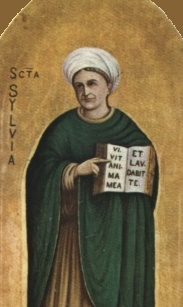Saint Silvia
Saint Silvia | |
|---|---|
 Saint Silvia by an altar painter; her eyes are erroneously depicted as dark instead of blue. | |
| Born | ~515 AD Rome or Sicily |
| Died | ~592 AD |
| Venerated in | Roman Catholic Church Eastern Orthodox Church |
| Feast | 3 November × |
| Patronage | Invoked by pregnant women for a safe delivery |
Saint Silvia (Sylvia) (c. 515 – c. 592) was the mother of Saint Gregory the Great. She is venerated as a saint by the Catholic Church and Eastern Orthodox Church,[1] which names her a patroness of pregnant women.
Life[]
Little biographical information about her exists. Her native place is sometimes given as Sicily, sometimes as Rome. Apparently she was of as distinguished family as her husband, the Roman regionarius, Gordianus. She had, besides Gregory, a second son, whose name did not survive through the ages.[2]
Silvia was noted for her great piety, and she gave her sons an excellent education. After the death of her husband, around 573, she devoted herself entirely to religion in the "new cell by the gate of blessed Paul" (cella nova juxta portam beati Pauli). Gregory the Great had a mosaic portrait of his parents executed at the monastery of Saint Andrew; it is minutely described by Johannes Diaconus (P.L., LXXV, 229–30).[3] Silvia was portrayed sitting with the face, in which the wrinkles of age could not hide the beauty; the eyes were large and blue, and the expression was gracious and animated.[2]
Veneration[]

The veneration of Saint Silvia is of early date.[2] She was honoured by the Romans as a type of a Christian widow.[3]
Silvia had built a chapel in her house. In 645, the monks from the monastery of Mar Saba (Palestine) settled in this house, and devoted it to the celebration of Saint Sabas. In the 9th century an oratory was erected over her former dwelling, near the Basilica of San Saba.
Pope Clement VIII (1592–1605) inserted her name under 3 November in the Roman Martyrology. She is invoked by pregnant women for a safe delivery.[4]
Two of her relatives, sisters-in-law Trasilla and Emiliana, are also venerated as saints, as well as her other sister-in-law Gordiana, and her husband Gordianus.
References[]
- ^ "03.11: Memoria di Santa Silvia Madre di s. Gregorio Magno (verso il 572 a Roma o tra il 590 e il 592)". www.ortodossia.it. Retrieved 2021-08-13.
- ^ a b c Klemens Löffler. “Saint Silvia”. Catholic Encyclopedia, 1913. CatholicSaints.Info. 9 August 2013
- ^ a b Monks of Ramsgate. “Sylvia”. Book of Saints, 1921. CatholicSaints.Info. 4 November 2016
- ^ “Saint Silvia of Rome”. "New Catholic Dictionary". CatholicSaints.Info. 9 August 2013
![]() This article incorporates text from a publication now in the public domain: Herbermann, Charles, ed. (1913). "Saint Silvia". Catholic Encyclopedia. New York: Robert Appleton Company.
This article incorporates text from a publication now in the public domain: Herbermann, Charles, ed. (1913). "Saint Silvia". Catholic Encyclopedia. New York: Robert Appleton Company.
External links[]
![]() Media related to Saint Silvia at Wikimedia Commons
Media related to Saint Silvia at Wikimedia Commons
- Saint Silvia at the
- (in Italian) Santa Silvia
- 515 births
- 592 deaths
- 6th-century Italo-Roman people
- 6th-century Byzantine people
- 6th-century Christian saints
- Italian Roman Catholic saints
- Female saints of medieval Italy
- 6th-century Italian women
- Pope Gregory I
- Medieval Italian saints